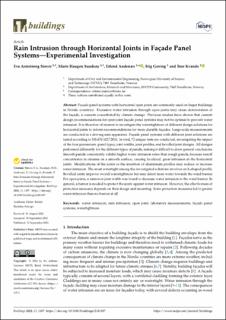| dc.description.abstract | Façade panel systems with horizontal open joints are commonly used on larger buildings in Nordic countries. Excessive water intrusion through open joints may cause deterioration of the façade, a concern exacerbated by climate change. Previous studies have shown that current design recommendations for open-joint façade panel systems may not be optimal to prevent water intrusion. It is therefore of interest to investigate the watertightness of different design solutions for horizontal joints to inform recommendations for more durable façades. Large-scale measurements are conducted in a driving rain apparatus. Façade panel systems with different joint solutions are tested according to NS-EN 1027:2016. In total, 72 unique tests are conducted, investigating the impact of the four parameters: panel types, joint widths, joint profiles, and bevelled joint designs. All designs performed differently for the different types of panels, making it difficult to draw general conclusions. Smooth panels consistently exhibit higher water intrusion rates than rough panels, because runoff concentrates in streams on a smooth surface, causing localized, great intrusion in the horizontal joints. Modifications of the joints or the insertion of aluminium profiles may reduce or increase water intrusion. The most watertight among the investigated solutions involves an h-shaped profile. Bevelled joints improve overall watertightness but may direct more water towards the wind barrier. For open joints, a narrower joint width was found to decrease water intrusion to the wind barrier. In general, a barrier is needed to protect the joints against water intrusion. However, the effectiveness of protection measures depends on their design and mounting. Some protection measures led to greater water intrusion than no barrier at all. | en_US |

